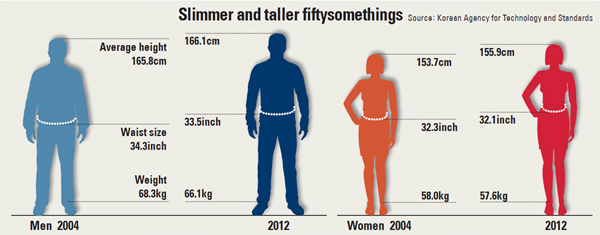Survey tracks the evolution of middle-aged bodies

The agency, which is under the Ministry of Knowledge Economy, looked into the body types of 1,228 Koreans aged 40 to 69 from June to October, by measuring 156 categories including height and widths of chest and waist. It is the second installment of the study, which began in 2004, and it detected changes in body types of both middle-aged men and women.
For men in their 40s, average height increased 1.3 centimeters (0.51 inch) from 168.6 centimeters to 169.9 compared to 2004, the agency said. Though the average height for men in their 50s and 60s remained unchanged, the average leg length of men in their 40s and 50s became grew by a centimeter. Measurement results also showed smaller average chest and waist sizes for middle-aged men.
Middle-aged women were also slimmer compared to 2008, the study showed.
The average height for women in their 40s increased by 2.4 centimeters, while those in their 50s and 60s jumped by 2.2 centimeters and 1.3 centimeters, respectively.
In addition, the average body mass indexes for men and women in different age groups were both smaller. The index for men in their 40s fell from 24.9 to 24.2, while for those in their 50s dropped from 24.8 to 23.8. There was no change seen in men aged 60 and older.
For women in their 40s, the index dropped from 23.6 to 22.9, while those in their 50s and 60s dropped from 24.6 to 23.7 and 25.3 to 24.7, respectively. A person is considered normal, or healthy, if the index is in between 18.5 and 25, while above that figure means someone is overweight.
“Middle-aged Koreans became slimmer because of changes in their lifestyle,” said Kim Yong-seok, a researcher at the agency. “The standard of living for these people, who were born in the 1960s and 1970s during Korean industrialization improved dramatically. They look after their health more than ever before.”
By Lee Eun-joo [angie@joongang.co.kr]










with the Korea JoongAng Daily
To write comments, please log in to one of the accounts.
Standards Board Policy (0/250자)